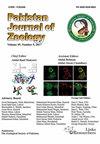巴基斯坦查谟和克什米尔加莫特国家公园鸟类多样性研究
IF 0.5
4区 生物学
Q4 ZOOLOGY
引用次数: 0
摘要
鸟类物种多样性和分布研究对保护工作具有重要意义。然而,Ghamot国家公园鸟类的丰富程度和分布情况尚不清楚。基于土地覆盖属性,将研究区划分为5类生境。在2020- 2021年期间,采用随机抽样方法,对30-50 m半径范围内的点样带进行软性计数。采用单因素方差分析对数据进行评价。本次研究共发现38科127种。在数量上占优势科(n=18;14.17%)最高个体数(n=938;24.26%)来自农业种植区(沿苏尔甘河;高寒草地、高寒草甸和湿地的个体数最少(n=113;2.92%)海拔在3950-4400米之间。夏候鸟47种(37%),留鸟59种(46.45%),非常年候鸟3种(2.36%),冬候鸟18种(14.17%)。记录最大种数(n=90;70.86%)种(+),但数量最少本文章由计算机程序翻译,如有差异,请以英文原文为准。
Study of Bird Diversity in Ghamot National Park Azad Jammu and Kashmir, Pakistan
Bird species diversity and distribution research is important for conservation efforts in various protected areas. However, the richness and distribution of birds in Ghamot National Park are unknown. Based on land cover attributes, the research region was divided into five habitat categories. During 2020-21, a point transect count was used softly up to 30-50 m radius with a random sample approach. One-way ANOVA was used to evaluate the data. This research discovered a total of 38 families totaling 127 species. Muscicapidae was numerically the dominant family (n=18; 14.17%) Highest number of individuals (n=938; 24.26%) was recorded from Agricultural crop zone (along the surgan stream; elevation ranges between 2750-3050m) Minimum number of individuals was recorded in alpine pasture, alpine meadows and wetland (n=113; 2.92%) at an elevation ranges between 3950-4400m. 47 (37%) species were recorded summer migrant, 59 (46.45%) were residential of study area, 3 (2.36%) species were recorded irregular year round migrant and 18 (14.17%) species were winter migrant. It was recorded that maximum number of species (n=90; 70.86%) breed (+) in study area however least number
求助全文
通过发布文献求助,成功后即可免费获取论文全文。
去求助
来源期刊

Pakistan Journal of Zoology
生物-动物学
CiteScore
1.10
自引率
16.70%
发文量
306
审稿时长
4.5 months
期刊介绍:
Pakistan Journal of Zoology (Pakistan J. Zool.) publishes original articles in English on all aspects of animal life. Generally these articles will be in, or related to one of the following subject areas: Physiology, Cell Biology, Molecular Biology, Genetics, Bioinformatics, Toxicology, Forensic Science, Developmental Biology, Entomology, Parasitology, Microbiology, Biotechnology, Pathology, Palaeontology. Taxonomy, Environmental Biology, Wildlife, Fisheries, Vertebrate and Invertebrate Morphology. Additionally, the journal considers research on health and clinical studies. Short communications are regularly considered, however, uninvited review articles, first records/reports of known species, case reports/studies and survey reports are not published in Pakistan Journal of Zoology.
 求助内容:
求助内容: 应助结果提醒方式:
应助结果提醒方式:


